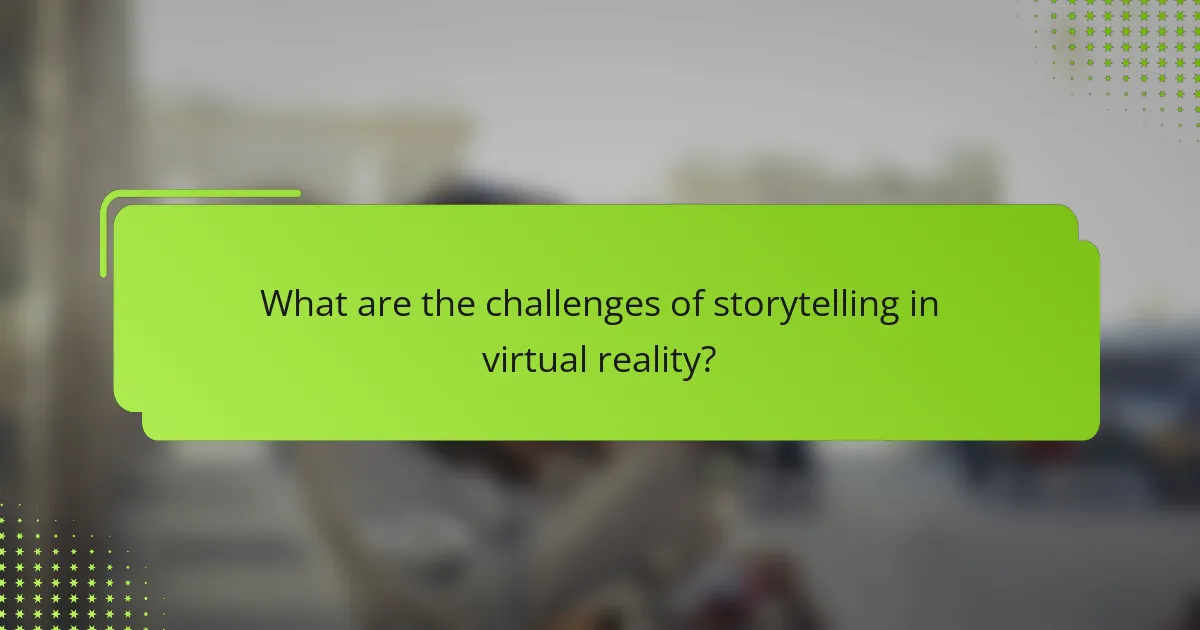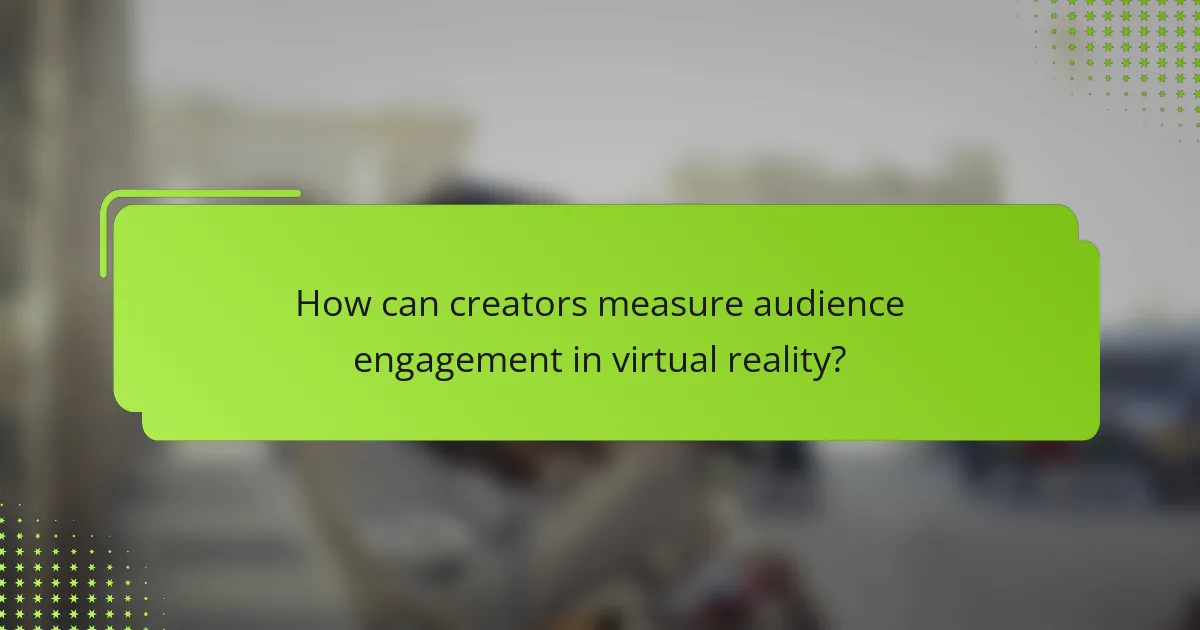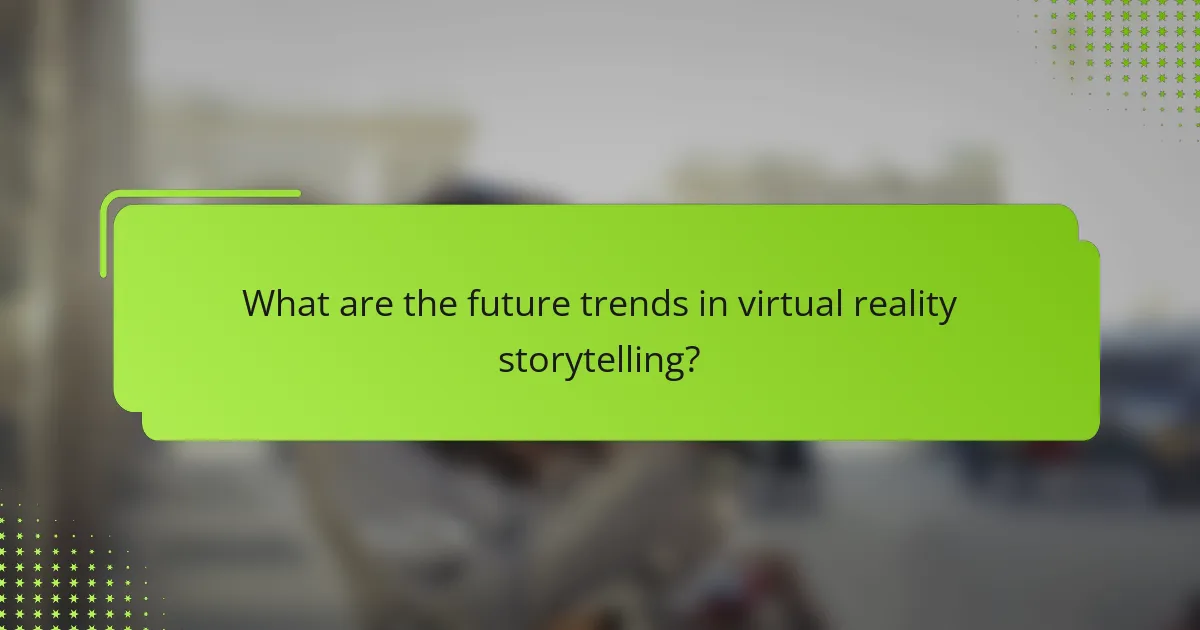Virtual reality (VR) revolutionizes storytelling by immersing audiences in interactive environments that foster deeper emotional connections and engagement. By transforming traditional narratives into dynamic experiences, users can influence outcomes and explore stories from various perspectives, enhancing their overall experience. Key techniques such as real-time feedback, social interactions, and gamification further elevate audience engagement, while visual fidelity, audio realism, and haptic feedback ensure a convincing sense of immersion.

How does virtual reality enhance storytelling?
Virtual reality (VR) enhances storytelling by immersing audiences in interactive environments that allow for deeper emotional connections and engagement. This technology transforms traditional narratives into experiences where users can influence outcomes and explore stories from multiple perspectives.
Immersive narratives
Immersive narratives in VR create a sense of presence, making users feel as if they are part of the story. By placing audiences directly within the narrative, they can experience events from the character’s viewpoint, which heightens emotional responses. For example, a VR film might allow viewers to walk alongside characters, witnessing their struggles and triumphs firsthand.
To effectively craft immersive narratives, creators should focus on strong world-building and character development. Engaging storylines that encourage exploration can lead to a more profound connection with the audience. Consider using sensory elements like sound and haptic feedback to enhance the experience further.
Interactive character development
Interactive character development allows users to influence character choices and relationships, making the story feel more personal. In VR, users can engage with characters through dialogue options or actions, leading to different story branches and outcomes. This interactivity fosters a sense of agency and investment in the narrative.
When designing interactive character arcs, ensure that choices have meaningful consequences. This can be achieved by creating multiple endings or altering character dynamics based on user decisions. Avoid overwhelming users with too many options; instead, focus on a few impactful choices that enhance the narrative flow.
Environmental storytelling
Environmental storytelling utilizes the surroundings to convey narrative elements without explicit dialogue. In VR, users can explore richly detailed environments that reveal backstory through visual cues, such as objects, architecture, and ambient sounds. This method encourages users to piece together the story through exploration.
To maximize the effectiveness of environmental storytelling, consider layering details that reward curiosity. For instance, hidden items or subtle changes in the environment can provide clues about the plot or character motivations. Balance the amount of information presented to avoid overwhelming users while still engaging their curiosity.

What are effective audience engagement techniques in virtual reality?
Effective audience engagement techniques in virtual reality (VR) include real-time feedback mechanisms, social interaction features, and gamification elements. These strategies enhance user experience by making interactions more immersive and participatory, ultimately leading to greater emotional investment and satisfaction.
Real-time feedback mechanisms
Real-time feedback mechanisms allow users to receive immediate responses to their actions within a VR environment. This can include visual cues, audio signals, or haptic feedback that reinforce user decisions and actions. For example, when a user successfully completes a task, they might see a visual celebration or hear an encouraging sound, enhancing their sense of achievement.
Incorporating these mechanisms can significantly improve user engagement by making experiences feel more dynamic and responsive. Developers should consider using low-latency technology to ensure that feedback is instantaneous, which helps maintain immersion and keeps users actively involved.
Social interaction features
Social interaction features in VR enable users to connect and communicate with others, fostering a sense of community. This can include voice chat, avatars, and collaborative tasks that require teamwork. For instance, in a VR game, players can strategize together in real-time, enhancing the overall experience through shared goals and achievements.
To maximize engagement, developers should ensure that social features are intuitive and accessible. Creating environments where users can easily find and interact with others can lead to longer session times and increased user satisfaction. It’s essential to consider privacy settings and moderation tools to create a safe and welcoming space for all participants.
Gamification elements
Gamification elements incorporate game-like features into VR experiences to motivate and engage users. This can include points, badges, leaderboards, and challenges that encourage users to complete tasks and explore the environment. For example, a VR training program might reward users with points for completing modules, incentivizing continued participation.
When implementing gamification, it’s crucial to balance challenge and skill to keep users engaged without causing frustration. Developers should also consider offering rewards that resonate with the target audience, such as virtual goods or exclusive content, to enhance motivation and retention.

What are the key components of immersion in virtual reality?
The key components of immersion in virtual reality (VR) include visual fidelity, audio realism, and haptic feedback. These elements work together to create a convincing and engaging experience that makes users feel as if they are truly part of the virtual environment.
Visual fidelity
Visual fidelity refers to the quality and realism of the graphics in a VR experience. High-resolution textures, realistic lighting, and detailed environments enhance the sense of presence, making the virtual world more believable. Aim for a frame rate of at least 90 frames per second to ensure smooth visuals, as lower rates can lead to discomfort or motion sickness.
When designing for visual fidelity, consider the hardware limitations of your target audience. For instance, high-end VR headsets like the Oculus Quest 2 or Valve Index can support advanced graphics, while more budget-friendly options may require simpler designs to maintain performance.
Audio realism
Audio realism plays a crucial role in immersion by providing spatial awareness and enhancing emotional engagement. 3D audio techniques allow users to perceive sounds coming from specific directions, which can significantly increase the feeling of being in a real environment. Use high-quality sound effects and ambient sounds to create a rich auditory landscape.
To optimize audio realism, consider using binaural audio techniques that simulate how humans naturally hear sounds. This can be particularly effective in VR storytelling, where sound cues can guide user attention and enhance narrative elements.
Haptic feedback
Haptic feedback involves the use of tactile sensations to simulate touch and interaction within the virtual world. This can include vibrations or force feedback from controllers or specialized gloves, which help users feel more connected to the virtual environment. Effective haptic feedback can make actions like picking up objects or feeling impacts more realistic.
When implementing haptic feedback, ensure that the sensations are synchronized with visual and audio cues to create a cohesive experience. Avoid overwhelming users with excessive feedback, as this can detract from immersion rather than enhance it. Aim for subtlety and relevance in haptic design to maintain user engagement.

What are the challenges of storytelling in virtual reality?
Storytelling in virtual reality (VR) faces several challenges that can hinder effective engagement and immersion. These include technical limitations, user experience design issues, and high content creation costs, all of which must be navigated to create compelling narratives.
Technical limitations
Technical limitations in VR can significantly impact storytelling. Hardware constraints, such as processing power and graphics capabilities, can restrict the complexity of environments and interactions. Additionally, issues like latency and frame rates can disrupt immersion, making it crucial to optimize performance for a seamless experience.
Developers must also consider compatibility across various VR platforms, as not all devices support the same features. This can lead to inconsistencies in storytelling elements, requiring careful planning to ensure a cohesive narrative across different systems.
User experience design
User experience design in VR is critical for effective storytelling. Unlike traditional media, VR requires users to actively engage with the environment, which can lead to disorientation if not designed thoughtfully. Ensuring intuitive navigation and interaction methods is essential to maintain immersion and keep the audience focused on the narrative.
Designers should prioritize user comfort by minimizing motion sickness and providing clear guidance within the experience. This can include using familiar visual cues or gradual introductions to complex interactions, allowing users to acclimate to the VR environment without losing sight of the story.
Content creation costs
The costs associated with content creation in VR can be substantial, often requiring specialized skills and technology. High-quality 3D modeling, animation, and sound design are essential for creating immersive experiences, which can lead to budgets in the tens of thousands of dollars or more, depending on the project’s scale.
To manage costs, creators can consider using modular assets or leveraging existing platforms that offer tools for VR storytelling. Collaborating with experienced professionals or utilizing freelance talent can also help streamline the production process while maintaining quality.

How can creators measure audience engagement in virtual reality?
Creators can measure audience engagement in virtual reality (VR) through various methods that provide insights into user interactions and experiences. Effective measurement combines quantitative data with qualitative feedback to understand how users connect with the VR content.
Analytics tools
Analytics tools are essential for tracking user behavior in VR environments. These tools can monitor metrics such as session duration, navigation paths, and interaction frequency. Popular platforms like Google Analytics and specialized VR analytics solutions can provide detailed reports on user engagement.
When selecting analytics tools, consider those that integrate seamlessly with your VR platform and offer real-time data. This allows for timely adjustments to enhance user experience based on observed behaviors.
User surveys
User surveys are a direct method to gather feedback from VR participants. By asking targeted questions about their experience, creators can gain insights into user satisfaction, emotional responses, and areas for improvement. Surveys can be conducted immediately after the VR experience or through follow-up emails.
To maximize response rates, keep surveys concise and focused. Offering incentives, such as discounts or exclusive content, can also encourage users to share their thoughts.
Engagement metrics
Engagement metrics provide a quantitative view of how users interact with VR content. Key metrics include retention rates, completion rates, and user interactions per session. These indicators help creators assess the effectiveness of their storytelling techniques and overall engagement strategies.
To interpret engagement metrics effectively, compare them against industry benchmarks. For instance, a retention rate above 50% is often considered strong in the VR space, indicating that users find the experience compelling enough to return.

What are the future trends in virtual reality storytelling?
The future of virtual reality storytelling is poised to evolve significantly, driven by advancements in technology and user expectations. Key trends include enhanced interactivity, more immersive experiences, and the integration of artificial intelligence to create personalized narratives.
Increased interactivity
Future virtual reality storytelling will focus on increased interactivity, allowing users to influence plot outcomes and character development. This shift will enable a more engaging experience, as audiences become active participants rather than passive viewers.
For instance, branching narratives where choices lead to different endings can enhance user investment. Developers should consider implementing decision trees that allow for multiple pathways, catering to diverse audience preferences.
Immersive environments
Creating immersive environments will be crucial for future VR storytelling. High-quality graphics, realistic soundscapes, and haptic feedback will contribute to a sense of presence, making users feel as if they are part of the story.
Utilizing technologies such as 360-degree video and spatial audio can significantly enhance immersion. Developers should prioritize optimizing these elements to create captivating worlds that draw users in.
Personalized experiences
Personalization will play a vital role in the evolution of virtual reality storytelling. By leveraging user data and artificial intelligence, creators can tailor narratives to individual preferences, enhancing emotional connections.
For example, VR experiences could adapt based on user choices, past interactions, or even emotional responses. This level of customization can lead to deeper engagement and satisfaction, making each experience unique.
Social interaction
Future trends in VR storytelling will likely emphasize social interaction, allowing users to share experiences with others in real-time. This can foster community building and collaborative storytelling, enhancing the overall experience.
Platforms that support multiplayer interactions or social spaces will be essential. Developers should explore features that enable users to communicate, collaborate, and share their journeys, creating a richer narrative experience.



